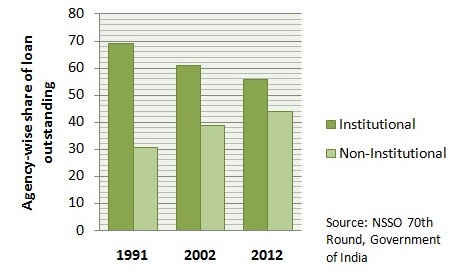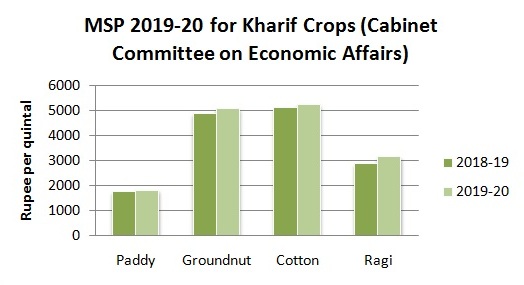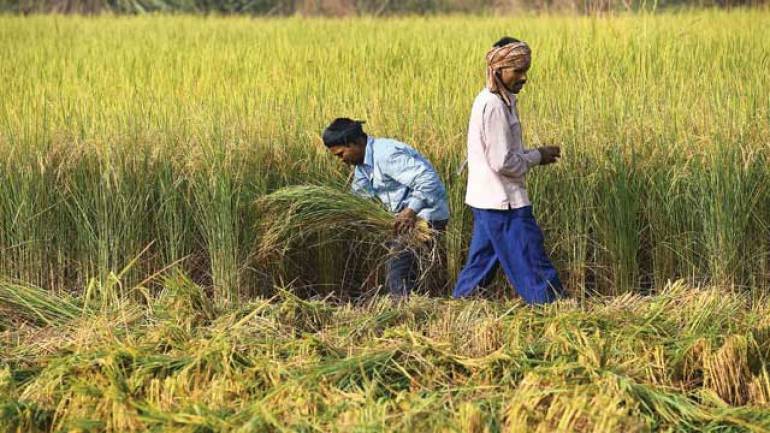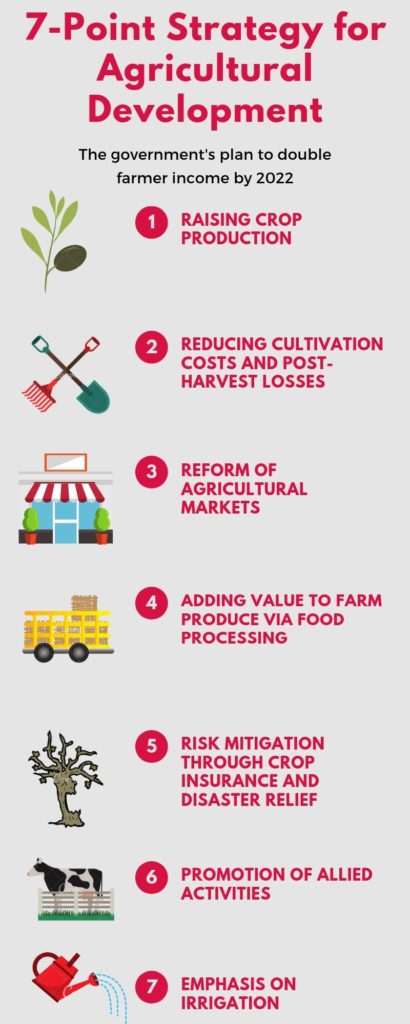By Parvathy Ramesh, University of Allahabad, Uttar Pradesh.
In the 1950s and 60s, the green revolution led to an overhaul of the agricultural sector in India. Following this period, production improved to such an extent that in the present year of 2019, India remains self-sufficient for almost all agricultural produce. However, this positive gain is offset by escalating issues of agrarian distress spread across the country – farmers living in abject poverty, low productivity compared to viable land, and growing indebtedness that result in suicide and distress migration. This distress is punctuated by headlines of death and mass protests, which leads us to examine the issues that give rise to such a wide-spread problem.
 Natural calamities are just one threat among many that agrarians face. Severe droughts in the states of Maharashtra, Karnataka and Gujarat have undoubtedly led to heavy losses in the recent past. Contrary to this situation, overabundance in the form of increased domestic output and excess foreign imports of produce has also led to a decline in market prices. Without proper storage services, these crops often go to waste, forcing the farmers to sell them at a loss and hampering their ability to pay back loans. The alarming increase in the rate of suicides has been attributed in part to the indebtedness from private lending sources. Loan waivers have often been brought up as a means to reduce the financial distress faced by farmers, but they provide little to no relief to those farmers whose landlessness makes them easy targets for growing numbers of unreliable, non-institutional lenders.
Natural calamities are just one threat among many that agrarians face. Severe droughts in the states of Maharashtra, Karnataka and Gujarat have undoubtedly led to heavy losses in the recent past. Contrary to this situation, overabundance in the form of increased domestic output and excess foreign imports of produce has also led to a decline in market prices. Without proper storage services, these crops often go to waste, forcing the farmers to sell them at a loss and hampering their ability to pay back loans. The alarming increase in the rate of suicides has been attributed in part to the indebtedness from private lending sources. Loan waivers have often been brought up as a means to reduce the financial distress faced by farmers, but they provide little to no relief to those farmers whose landlessness makes them easy targets for growing numbers of unreliable, non-institutional lenders.
Adding to this issue is the problem of low productivity. Primitive agricultural practices result in low yield. While India is capable of introducing innovative means for agriculture such as precision farming, and opting for mechanisation of agricultural tools and labour, these measures will fail unless the problem of proper irrigation is tackled first. A Long-Term Irrigation Fund has been set up exclusively for this purpose, with a planned completion date in December 2019. However, the problems do not end with the harvest season. Farmers are often underpaid and receive scant payment for the fruits of their labour, which are then distributed and sold at higher prices. Protection from unfair pricing by private buyers and reduced rates caused by an abundance of crops would thus be necessary to ensure that farmers are duly compensated. What steps has the government taken to combat this?
Half-hearted Solutions
Growth of investment in agriculture has rapidly declined, with real investment in agriculture decreasing at 2.3% per annum during 2013-14 and 2016-15. In an attempt to rectify this, farmers possessing up to 2 hectares of land were promised an income in the form of Rs. 6000 per annum distributed through instalments, under a scheme called PM-Kisan Samman Nidhi. While it is an appreciable measure, the mandatory cut-off at 2 hectares of land does not discriminate between irrigated and non-irrigated land, even though it is known that the former fetches higher returns. And much like the loan waivers, such steps only provide temporary relief to a problem that needs to be tackled at the grassroots level.
 Establishing a Minimum Support Price (MSP) was another measure by the government to buy crops from farmers at a fair price, as a means of ensuring that farmers would not face undue loss in the market. It was recommended that the MSP should be set at a minimum of 50% more than the weighted average cost of production. Currently, the MSP is 1.5 times the cost of production. However, economic experts have pointed out that setting an MSP has not shown the expected improvement, as most Indian markets are facing an issue of overproduction, resulting in agricultural products being sold in wholesale markets at prices falling short of the MSP. In addition to this, increased MSP results in higher retail prices, putting off potential buyers.
Establishing a Minimum Support Price (MSP) was another measure by the government to buy crops from farmers at a fair price, as a means of ensuring that farmers would not face undue loss in the market. It was recommended that the MSP should be set at a minimum of 50% more than the weighted average cost of production. Currently, the MSP is 1.5 times the cost of production. However, economic experts have pointed out that setting an MSP has not shown the expected improvement, as most Indian markets are facing an issue of overproduction, resulting in agricultural products being sold in wholesale markets at prices falling short of the MSP. In addition to this, increased MSP results in higher retail prices, putting off potential buyers.
The Swaminathan Commission, officially called the National Commission on Farmers, was set up by the United Progressive Alliance to recommend policies and reformations in the field of agriculture. Government investment in agriculture in the form of changes to the land development, improvement in conservation, and sustainable changes in irrigation practices were part of the recommendations provided by the Commission. Monetary measures were also recommended – this includes extension of MSP to other crops such as cereals, loan waivers in areas under distress and funds set aside for areas facing natural calamities, provision of loans at lower interest rates, outreach programmes to offer credit in certain areas etc. As promising as these measures may seem, most are yet to be implemented, and those that have been unveiled now suffer from low enrolment rates. The agricultural sector has seen a jump of more than 92% in the present budget, with the Finance Minister specifically mentioning zero budget farming – i.e. farming without using credit or spending on inputs. Most of this budget is centred on PM-Kisan Samman Nidhi, with only a meagre increase in crucial areas such as agricultural research, fertiliser subsidies, and irrigation.
What the Experts Say: Measures to Reduce the Distress
The government has taken a step in the right direction with the setup of MSP. Still, there is ample debate about the need for changes in this policy with respect to the cost of production, and the type of funds that contribute to this amount. Researchers at the Indira Gandhi Institute of Development Research suggest exclusion of lease rental in MSP, as this would otherwise lead to an increase in the government’s food subsidy owing to landlords who would have significantly more marketable surplus. Insurance against crop loss is another area where government policies can play a role. This includes an insurance cover that should include farm products that fall short of the MSP, so that farmers would not be forced to apply for loan waivers in the event that their crops fail in the market. It is estimated that the increased cost of this insurance cover would be less compared to the loss created by loan waiver programmes.
States like Madhya Pradesh and Chhattisgarh possess the infrastructure and experience to procure wheat, rice, and paddy. Recognising this, a panel appointed by the government has suggested that procurement of these crops could be handed over to these states in exchange for direct subsidies, instead of leaving this responsibility entirely to the Food Corporation of India (FCI). Researchers are doubtful that the government would be able to implement such a large-scale procurement plan, given the outstanding dues to the FCI due to mismatch between the actual expenses and the allocated budget. However, the introduction of a producer’s company by farmers could be a possible solution, as proposed by the Finance Minister in the Union Budget for 2018-19. It is estimated that at least 1 lakh Farmer Producer Companies (FPCs) would be required to transform agriculture in India, as opposed to the 10,000 proposed in the 2019 Union Budget. Despite the effort it would take to mobilise farmers to carry this out, these FPCs could potentially provide farmers with requisite remuneration and improve their involvement in the post-harvest chain.
These recommended points all feature among the strategies planned by the government to double farmer income by 2022. What also needs to be kept in mind is that frequent changes to policy could cause instability in the market, harming the agrarians further. Furthermore, it needs to be acknowledged that introducing and modifying policies strictly centred on agricultural development will not necessarily reduce suicide rates and migration. Thus, it is necessary to establish policies independent of agricultural finance and price regulation, and introduce new ones to protect and provide incentives to those agrarians who decide to exit the agricultural sector or branch out. This could be in the form of introducing schemes to encourage self-employment in non-farm activities and providing incentives to promote rural entrepreneurship. Whether it is to help farmers acquire additional sources of income or maximise their current agricultural potential, one can see from the measures already taken that it is not lack of scientific studies or innovative ideas that are hindering the agricultural sector, rather, it is the failure to implement these plans that have resulted in a lack of long-term, sustainable solutions. Hence, with every change in the proposed policy, we should ask ourselves the most important question: can one be optimistic about the government’s ability to bring these plans to fruition?


